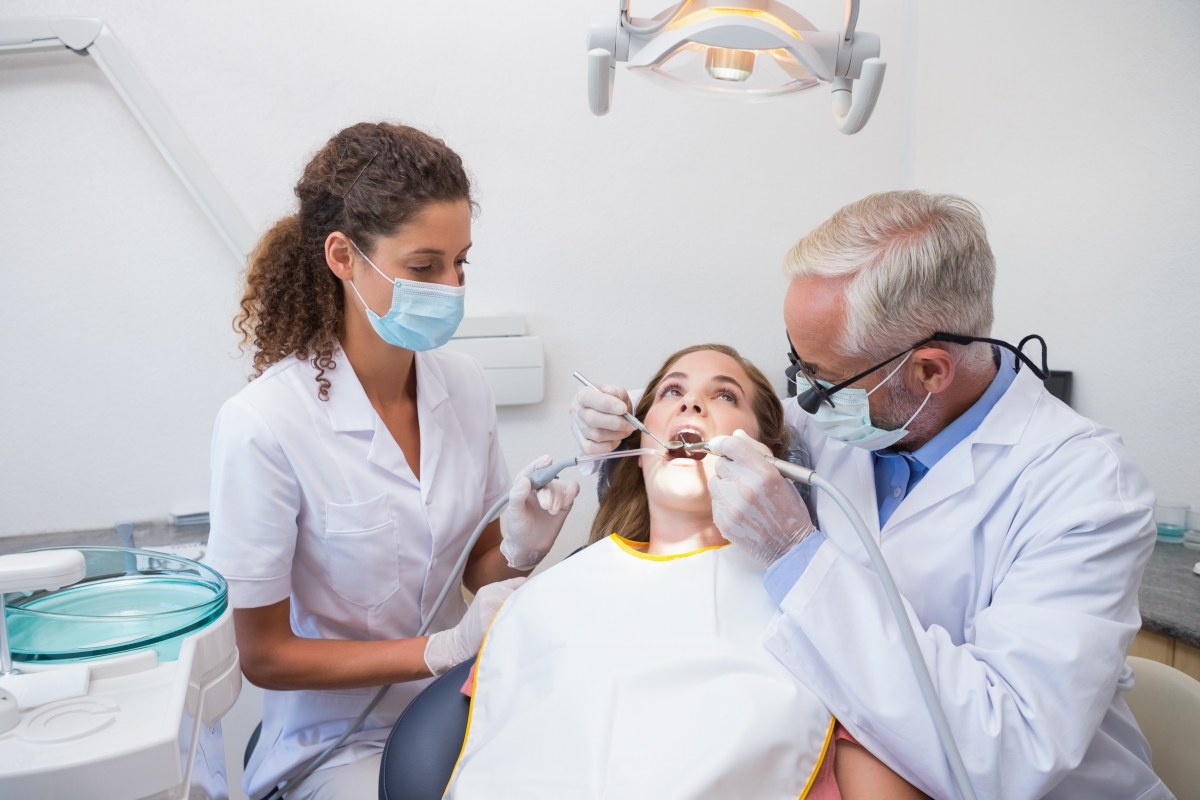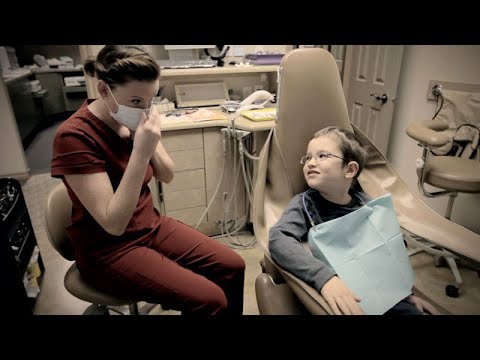Career Overview
Dental assistants:
- Assist dentists, dental hygienists and dental therapists while patients are being examined and treated
- Perform clerical work
- Work in dentists' offices, community health centres, clinics and in educational institutions
Dental laboratory assistants:
- Assist dental technologists and technicians in preparing and fabricating dentures and other dental devices
- Work in dental laboratories
Job Titles
Duties
Dental assistants can be certified or uncertified. Only certified dental assistants (CDAs) may perform “intra-oral” duties inside a patient’s mouth. Uncertified or “chairside” dental assistants perform only “extra-oral” duties outside a patient’s mouth.
Certified dental assistants:
- Take and develop X-rays
- Polish teeth and clinical crowns
- Apply fluoride and sealant
- Take preliminary impressions for diagnostic casts
- Make temporary crowns and restorations
- Remove stitches from wounds
- Take and record vital signs as needed
- Apply and remove rubber dams for dental procedures
- Apply topical anaesthetic and agents to reduce sensitivity and tooth decay
- May perform pulp vitality testing
- May perform periodontal screening and recording
Chairside dental assistants:
- Schedule appointments
- Keep records of patients’ dental work
- Prepare patients for dental exams and help the dentist during the examination
- Sterilize and maintain dental instruments and equipment
- Prepare dental instruments and filling materials
- Teach patients about oral hygiene
- Invoice patients
- Order dental and office supplies
Under a dentist’s supervision, chairside dental assistants with a radiography designation can also expose X-rays.
Dental laboratory assistants:
- Prepare plaster models and moulds from dental impressions
- Prepare wax bite-blocks and impression trays
- Cast gold or metal alloys for bridges and denture bases
- Pack plastic material in moulds to form full or partial dentures
- Mould wax over denture set-up to form full contours of artificial gums
- Make orthodontic bands from gold, silver, stainless steel or other metals
- Finish metal framework of dentures and polish and buff dentures to obtain natural finish
Earnings
Earnings is income that workers receive in exchange for their labour. Depending on the type of employment, earnings can be in the form of wages (hourly), salaries (fixed monthly or annual) or self-employed earnings.
Work Environment
# Workers Employed
5,935% Employed Full Time
26%Dental assistants work in clean, well-lit dentists’ and orthodontists’ offices, hospitals, public health centres, clinics and educational institutions. They usually work 40 hours per week. Some may work Saturdays or evenings.
Dental assistants wear gloves, masks, eyewear and protective clothing to shield themselves and their patients from infection. They follow safety procedures when taking X-rays.
Dental laboratory assistants work takes place in a laboratory environment and may use instruments or power tools that could be a source of injury.
Career Pathways
With additional training and licensing, a chairside assistant can become a certified dental assistant (CDA).
CDAs who wish to specialize can train in orthodontics (straightening teeth) or prosthodontics (replacing teeth). Chairside assistants can learn to expose X-rays by training in dental radiography.
Dental assistants may advance to senior CDAs, clinic or office managers, treatment co-ordinators, administrators, researchers, instructors or sales representatives. They can also enrol in a bridging program and train to become dental hygienists.
Dental laboratory bench workers may progress to dental technologists and technicians positions with training, experience and registration.
Occupational Interests
It’s important to understand what kinds of occupations align with your interests.
For more about occupational interests visit Skills for the Future Workforce > Characteristics.
Here are the top occupational interest(s) for this career profile:
Education, Training and Skills
Dental laboratory assistants usually require secondary school and up to two years of on-the-job training
Chairside dental assistants generally need a secondary school diploma and on-the-job training. They're not regulated and don't need to be certified.
Certified dental assistants (CDAs) must complete an approved CDA program. This usually takes eight months to one year. They must then be certified by the British Columbia College of Oral Health Professionals (BCCOHP). CDAs must earn 36 continuing education credits every three years to keep their licence.
Dental assistants who have completed an accredited CDA program outside of B.C. can apply to BCCOHP for certification. CDAs who wish to renew their licence and those with foreign qualifications can take written and clinical exams through the National Dental Assisting Examining Board.
Dental assistants who are certified for that occupation by a regulator elsewhere in Canada can apply for the same certification from the regulator in B.C. Under the terms of the Canadian Free Trade Agreement (CFTA), most applicants who are transferring their credentials from elsewhere in Canada will not be required to complete additional training or testing. However, the B.C. regulator may ask applicants to provide further information such as a letter of good standing, references, or criminal record check.
For those who trained outside of Canada and never received certification from any Canadian jurisdiction, a full assessment is likely needed. Most occupational regulators have a process for assessment and recognize internationally trained applicants.
Contact the British Columbia College of Oral Health Professionals (BCCOHP) for details on how to apply for certification in B.C.
For information about labour mobility in Canada, visit www.workersmobility.ca.
View a list of Professional Regulatory Authorities in B.C.
Education programs in B.C.

Top Skills
Every job calls for a certain set of skills. Knowing those skills is the first step in finding a good career fit.
Here, you will find the 10 most relevant workplace skills. Some are more important to achieving success in a certain career than others. These skills may come naturally to you or you may need to gain them through education, training and experience.
See the list of work-related skills below, ranked in order of importance for this career. Check out the list and see if this career matches your skills—take that first step!
Giving full attention to what other people are saying, taking time to understand the points being made, asking questions as appropriate, and not interrupting at inappropriate times.
Understanding written sentences and paragraphs in work-related documents.
Talking to others to share information effectively.
Using logic and reasoning to identify the strengths and weaknesses of alternative solutions, conclusions or approaches to problems.
Understanding how new information could be used to solve current and future problems in making decisions.
Keeping track of and assessing your performance, other individuals, or organizations to make improvements or take corrective action.
Being able to solve novel, ill-defined problems in complex, real-world settings.
Managing one’s own time and the time of others.
Being aware of others’ reactions and understanding why they react as they do.
Considering the relative costs and benefits of potential actions to choose the most appropriate one.
Labour Market Statistics
Discover data, facts and information that have been gathered and analyzed. Learn about the characteristics of the economy and labour market in B.C.
Employment
Find out about employment types and trends by region and industry.
Employment
5,935Employment by Region







| Region | Employment | % Employment of this Occupation |
|---|---|---|
| Cariboo | 180 | 3.0% |
| Kootenay | 165 | 2.8% |
| Mainland/Southwest | 3,820 | 64.4% |
| North Coast and Nechako | 85 | 1.4% |
| Northeast | 60 | 1.0% |
| Thompson-Okanagan | 635 | 10.7% |
| Vancouver Island/Coast | 980 | 16.5% |
Labour Market Outlook
The B.C. Labour Market Outlook is a 10-year forecast of the expected supply and demand for labour in the province. It’s usually updated every year. The purpose is to provide British Columbians with the knowledge to make informed decisions on careers, skills training, education and hiring.
Forecasted Job Openings (2025-2035)
3,130Forecasted Job Openings
Forecasted Employment Growth Rate
Composition of Job Openings
Job Openings by Region (2025-2035)







| Region | Job Openings | Avg. Annual Employment Growth |
|---|---|---|
| Cariboo | 70 | 2.2% |
| Kootenay | 120 | 2.2% |
| Mainland/Southwest | 2,110 | 2.2% |
| North Coast and Nechako | 40 | 2.5% |
| Northeast | 20 | 1.2% |
| Thompson-Okanagan | 320 | 2.1% |
| Vancouver Island/Coast | 450 | 2.3% |
Industry Highlights
Learn about the opportunities in B.C.'s major industries, including employment trends, earning potential, locations of work and more.
Forecasted Job Openings by Industry
| Industry | Job Openings (2025-2035) |
|---|---|
| Health Care and Social Assistance | 3,060 |
| Manufacturing | 30 |
| Educational Services | 10 |
| Construction | 10 |
| Business, Building and Other Support Services | 10 |
Insights from Industry
Demand for dental assistants is expected to remain strong as B.C.’s population grows, as people become more aware of good dental hygiene and as they keep their natural teeth longer. Demand for cosmetic dental work, such as laser whitening and caps, is also growing.
Because certified dental assistants can perform a wider range of duties than chairside dental assistants, they have more job opportunities and higher salaries.
Resources
-
B.C. Ministry of Healthwww.gov.bc.ca/health
-
British Columbia Dental Association (BCDA) – Careersbcdental.org/careers/
-
Canadian Dental Assistants Association (CDAA)www.cdaa.ca
-
Certified Dental Assistants of British Columbia – Job Boardwww.cdabc.org/employment/job-board
-
Certified Dental Assistants of British Columbia (CDABC)www.cdabc.org
-
British Columbia College of Oral Health Professionals (BCCOHP)oralhealthbc.ca/








